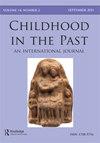Child labour based on dermatoglyphic research of ceramic objects
IF 0.5
Q3 ANTHROPOLOGY
引用次数: 5
Abstract
ABSTRACT Methods that examine finger and hand prints are still rarely used in the analysis of archaeological artefacts, even though objects made from clay have perfectly preserved traces of their creators, left hundreds or even thousands of years ago. Information coded in these prints can be examined by searching for repetition and distribution of individual or typical characteristics. This article focuses on the breadth of papillary lines and how it changed as the person grew. The prints left on ceramic objects from the thirteenth–eighteenth century layers at Vilnius Castle were examined and children's prints were identified on approximately twenty-five percent of the material with dermatoglyphics. Analysis of the results serves as the basis for assessing the nature and scale of child labour.基于陶瓷物件皮纹研究的童工
研究手指和手印的方法仍然很少用于考古文物的分析,即使由粘土制成的物品完好地保存了它们的创造者的痕迹,这些痕迹是几百年甚至几千年前留下的。通过寻找个体或典型特征的重复和分布,可以检查这些指纹中编码的信息。这篇文章的重点是乳突线的宽度,以及它是如何随着人的成长而变化的。研究人员检查了维尔纽斯城堡13 - 18世纪陶瓷制品上留下的指纹,发现大约25%的材料上有儿童的皮肤刻字。对调查结果的分析是评估童工的性质和规模的基础。
本文章由计算机程序翻译,如有差异,请以英文原文为准。
求助全文
约1分钟内获得全文
求助全文
来源期刊

Childhood in the Past
Social Sciences-Anthropology
CiteScore
0.90
自引率
0.00%
发文量
16
期刊介绍:
Childhood in the Past provides a peer-reviewed, interdisciplinary, international forum for the publication of research into all aspects of children and childhood in the past, which transcends conventional intellectual, disciplinary, geographical and chronological boundaries. The editor welcomes offers of papers from any field of study which can further knowledge and understanding of the nature and experience of childhood in the past.
 求助内容:
求助内容: 应助结果提醒方式:
应助结果提醒方式:


